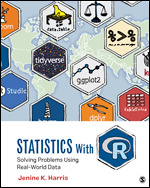Statistics With R
Solving Problems Using Real-World Data
- Jenine K. Harris - Washington University in St.Louis, USA
“Statistics with R is easily the most accessible and almost fun introduction to statistics and R that I have read. Even the most hesitant student is likely to embrace the material with this text.”
—David A.M. Peterson, Department of Political Science, Iowa State University
Drawing on examples from across the social and behavioral sciences, Statistics with R: Solving Problems Using Real-World Data introduces foundational statistics concepts with beginner-friendly R programming in an exploration of the world’s tricky problems faced by the “R Team” characters. Inspired by the programming group “R Ladies,” the R Team works together to master the skills of statistical analysis and data visualization to untangle real-world, messy data using R. The storylines draw students into investigating contemporary issues such as marijuana legalization, voter registration, and the opioid epidemic, and lead them step-by-step through full-color illustrations of R statistics and interactive exercises.
Included with this title:
The password-protected Instructor Resource Site (formally known as Sage Edge) offers access to all text-specific resources, including a test bank and editable, chapter-specific PowerPoint® slides. Learn more.
Supplements
edge.sagepub.com/harris1e
The open-access Student Study Site makes it easy for students to maximize their study time, anywhere, anytime. It offers flashcards that strengthen understanding of key terms and concepts, as well as learning objectives that reinforce the most important material.
For additional information, custom options, or to request a personalized walkthrough of these resources, please contact your sales representative.
edge.sagepub.com/harris1e
The open-access Student Study Site makes it easy for students to maximize their study time, anywhere, anytime. It offers flashcards that strengthen understanding of key terms and concepts, as well as learning objectives that reinforce the most important material.
For additional information, custom options, or to request a personalized walkthrough of these resources, please contact your sales representative.
“Statistics With R is easily the most accessible and almost fun introduction to statistics and R that I have read. Even the most hesitant student is likely to embrace the material with this text.”
“This is an entertaining and unorthodox text that explains statistical concepts in a way that engages students and rewards them for achievements. As useful to instructors as it is to their students.”
“This text makes the R statistics software accessible to all students by providing excellent examples and step-by-step processes. The student gains mastery over statistical analysis that can be applied to the real world.”
“This is an engaging textbook for learning statistics and R at the same time.”
“Using a simple but engaging style, this textbook relies on three friendly characters to introduce and explore the most common statistical problems students will face in their career. And, as a bonus, students learn how to use and master R for analyzing and illustrating simple and complex data sets.”
“There are many good statistics textbooks on the market- and there are equally good books that teach R; there are very few that do both. This book fills this gap. Students who use this text will benefit not only from having a top-notch stats textbook, but a great resource for how to conduct their analysis in R.”
“Allowing students to see how statistics is actually relevant to them through guided stories is a priceless experience. This text provides cross-cutting skills in R programming that students can take away with them for their CVs/résumés and career development."
“A unique introduction to statistics using characters in a storyline who are themselves learning how to solve real case studies using the R programming language. The first statistics textbook of its kind!”
“This is a wonderful, innovative statistics text that integrates R coding into learning about quantitative methods. The highly engaging lessons walk students through each stage of the analytical process and teach students how to perform a statistical analysis, including the presentation of results in graphical form, using code.”
Too advanced for undergraduate students, probably appropriate for those in research-oriented program.

